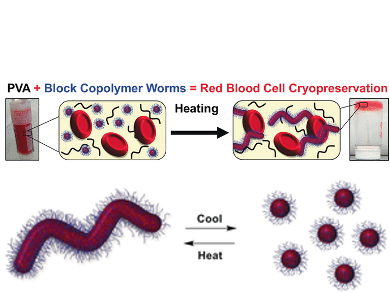Cryoprotecting Agents for Red Blood Cells
Freezing of medical tissue and cells usually requires the addition of cryopreservatives, although the added compounds can have undesired effects in subsequent applications. In the journal Angewandte Chemie, British scientists report on the synthesis of a block copolymer hydrogel, which not only facilitates the cryoprotection of red blood cells, but also serves as a suitable matrix for further tissue engineering. This points to an attractive one-pot solution for whole blood cryopreservation and tissue-engineering applications.
Freezing and thawing imposes enormous stress on the living cell, but long-term storage of medical samples is often possible only in the frozen state. To prevent ice-induced damage during freezing, anti-freeze compounds are commonly added that mimic the water environment and replace the water molecules from the cell components. Water-miscible organic solvents, glycoproteins, and engineered starch have been used for this purpose, but they share biocompatibility issues, and stripping off the solvents from the cells can be challenging as well. Seeking for alternatives, Matthew I. Gibson and Daniel E. Mitchell from the University of Warwick in collaboration with Steven P. Armes and Joseph R. Lovett at the University of Sheffield have synthesized a block copolymer hydrogel that is an excellent cryopreserving agent when used in tandem with ice-growth inhibiting polymers. It can also be used as a hydrogel matrix for cultivation and further engineering of the thawed cells.
Block Copolymer Hydrogels
This block copolymer hydrogel comes in nanometer-sized worm-like shape if it is warm, but changes its appearance in the cold: “Such worms form a soft, free-standing aqueous hydrogel at 20 °C, but undergo a reversible worm-to-sphere transition upon cooling below 12 °C,” the scientists say. In the worm-shaped (hydrogel) state, it makes up a suitable matrix for tissue engineering, while in the spheric state it is a fluid that allows facile cell and tissue sterilization by ultrafiltration.
The most important property, however, is cryoprotection. The scientists show that the gel worms form a hydrated matrix around the cells, replacing the water. Although the worms alone cannot protect the cells, in conjugation with the biocompatible polymer that inhibits ice recrystallization, significant cell recovery is possible, the authors say. “This is the first demonstration that a wholly synthetic (polymer or otherwise) formulation can be used to achieve efficient cell cryopreservation.” The gel can be further optimized by rational design. One hydrogel – two applications, or, as the authors put it: “an attractive one-pot solution for future whole-blood cryopreservation and tissue-engineering applications.”
- Combining Biomimetic Block Copolymer Worms with an Ice-Inhibiting Polymer for the Solvent-Free Cryopreservation of Red Blood Cells,
Daniel E. Mitchell, Joseph R. Lovett, Steven P. Armes, Matthew I. Gibson,
Angew. Chem. Int. Ed. 2016.
DOI: 10.1002/anie.201511454




